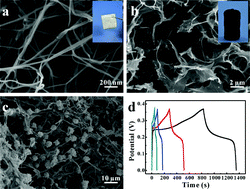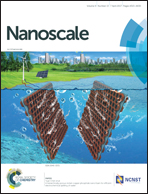Bacterial cellulose-based sheet-like carbon aerogels for the in situ growth of nickel sulfide as high performance electrode materials for asymmetric supercapacitors†
Abstract
Electroactive materials, such as nickel sulfide (NiS), with high theoretical capacities have attracted broad interest to fabricate highly efficient supercapacitors. Preventing aggregation and increasing the conductivity of NiS particles are key challenging tasks to fully achieve excellent electrochemical properties of NiS. One effective approach to solve these problems is to combine NiS with highly porous and conductive carbon materials such as carbon aerogels. In this study, a green and facile method for the in situ growth of NiS particles on bacterial cellulose (BC)-derived sheet-like carbon aerogels (CAs) has been reported. CA prepared by the dissolution–gelation–carbonization process was used as a framework to construct NiS/CA composite aerogels with NiS uniformly decorated on the pore walls of CA. It was found that the NiS/CA composite aerogel electrodes exhibit excellent capacitive performance with high specific capacitance (1606 F g−1), good rate capacitance retention (69% at 10 A g−1), and enhanced cycling stability (91.2% retention after 10 000 continuous cyclic voltammetry cycles at 100 mV s−1). Furthermore, asymmetric supercapacitors (ASCs) were constructed utilizing NiS/CA composite and CA as the positive and negative electrode materials, respectively. Through the synergistic effect of three-dimensional porous structures and conductive networks derived from CA and the high capacitive performance offered by NiS, the ASC device exhibited an energy density of ∼21.5 Wh kg−1 and a power density of 700 W kg−1 at the working voltage of 1.4 V in 2 M KOH aqueous solution. The ASC device also showed excellent long-term cycle stability with ∼87.1% specific capacitance retention after 10 000 cycles of cyclic voltammetry scans. Therefore, the NiS/CA composite shows great potential as a promising alternative to high-performance electrode materials for supercapacitors.



 Please wait while we load your content...
Please wait while we load your content...